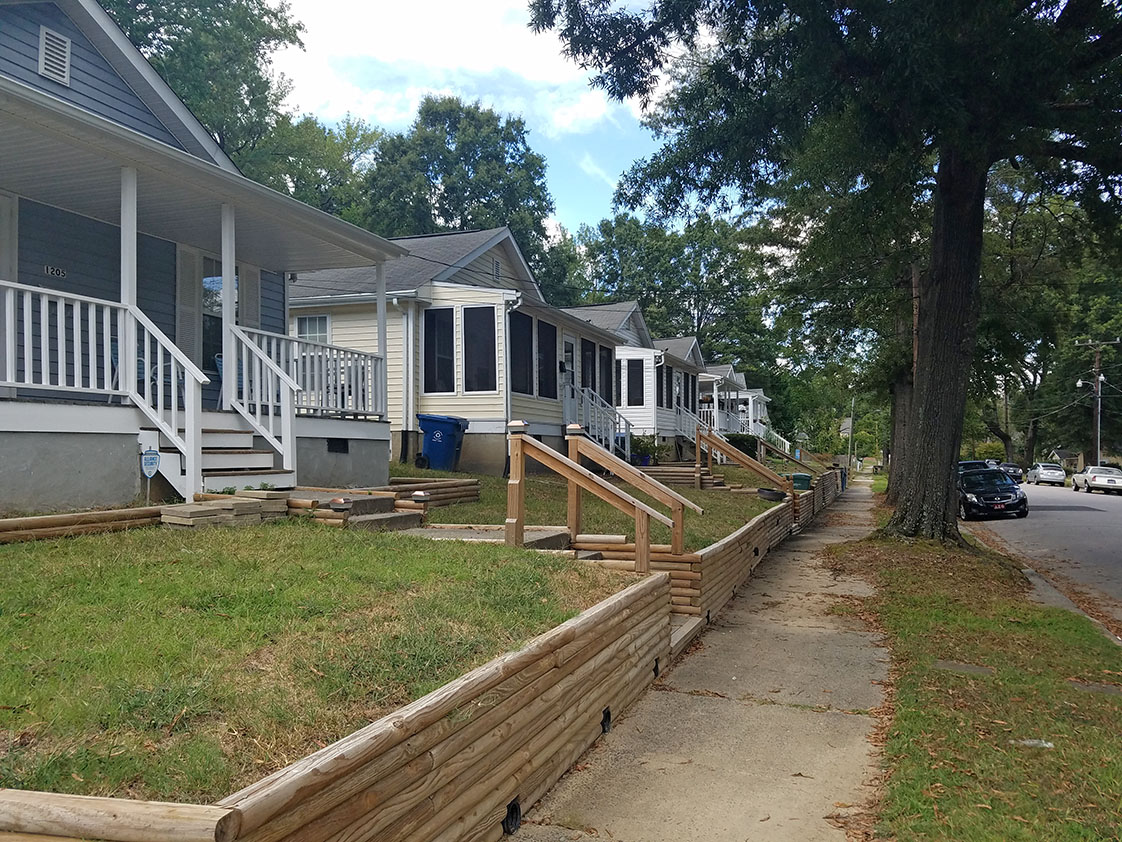
A house on Lancaster St undergoes major renovations. Friday, Sept. 16, 2016. (Staff photo by L'erin Jensen)
Once an almost exclusively black neighborhood, Walltown Village with its close proximity to Duke, has been undergoing gentrification for more than a decade. However, according to Walltown residents, Sammy Lucas and Felix Hayes, the process hasn’t been all bad, and the newcomers are becoming a part of the community.
According to “Walltown: The History of a Neigborhood and a Housing Renovation Program” by Heather Christine Deutsch, Walltown was named after George Wall, a former slave and janitor at then Trinity College, who bought a plot of land from the Durham Consolidated Land and Improvement Company and built a home. Despite this, Walltown could very well have been named for its isolation from the surrounding, much whiter, communities.
While Walltown was an almost exclusively black neighborhood throughout the 1970s, the communities surrounding it, like Trinity Park, were almost exclusively white. Walltown was made up of working-class blacks, most of whom worked at what is now Duke University.

Small one-story frame dwellings were common during Walltown’s development in the early 1900s. Sunday, Sept. 18, 2016.(Staff photo by L’erin Jensen)
Small one-story frame dwellings on Berkeley St. Houses built in this style were common during Walltown’s development in the early 1900s.
Today, however, almost a third of the once exclusively black neighborhood’s residents are white, according to city-data.com. Mel Norton, a board member of the Durham People’s Alliance, told the News & Observer that home prices in six Central Durham neighborhoods, including Walltown, rose more than 400 percent from 2005-2015.
Lucas, a longtime Walltown resident who dresses in a suit and tie and carries a bible around and who likes to call himself “Mr. Walltown” said the owners will “fix a few things on the house, then increase the rent by $500.”
When asked if he knew any people who had been kicked out of their homes because their landlord did some renovations or sold the home to new owners, he responded with an emphatic, “Yes. Lots.”
Hayes, a 30-year-resident of Walltown, said, “The neighborhood has changed a lot.” However, he explained that all of the changes haven’t been so bad.
Hayes said his street was at one time “filled with liquor houses”. Hayes says now that the liquor houses are gone, the neighborhood is less dangerous than it once was.
The effects of gentrification are glaring if one walks down any street in Walltown. It’s not uncommon to see a 20-something hipster riding his/her bike home.
Almost every street in Walltown is a mixture of older homes that are in dire need of repair, and newly-renovated homes, some with yoga balls on the front porch. Many streets also have homes that are currently in the process of being renovated.
But the new members of the Walltown neighborhood are also members of the community. What was once a segregated community has become integrated.
Lucas aka Mr. Walltown casually walked into the home of a white family, as if it were his own. A little girl with a broken arm and bright-pink cast came downstairs and was happy to see him.
At the dining room table, Lucas explained that Walltown’s new residents were not unwelcome.
Like Hayes, Lucas agrees that the neighborhood is safer now than when liquor houses filled the neighborhood. Nonetheless, he also noted that just because longtime members of the community were accepting of the new residents doesn’t mean that they should forget the past.
Walltown isn’t Durham’s only neighborhood undergoing gentrification.
Durham’s Southside neighborhood once had a vacancy rate of almost 25 percent. The city took on a project to create mixed-income apartments and spent $20 million to build the Lofts at Southside.
The idea was to bring back residents who lived in the neighborhood before revitalization. Mayor Pro-Tempore of Durham, Cora Cole-McFadden, said, “Most came back. Not to the extent we wanted, and not all look like what we thought. But that’s okay, because that’s Durham.”
For many in Walltown, the feeling is similar. The invisible wall no longer exists. Instead bridges have been built, and new residents have become a part of the community.